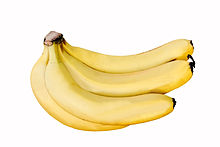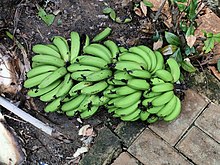| Cavendish | |
|---|---|
 A bunch of Cavendish bananas | |
| Species | Musa acuminata |
| Cultivar group | Cavendish subgroup of the AAA Group |
| Cultivar group members | See text |

Cavendish bananas are the fruits of one of a number of banana cultivars belonging to the Cavendish subgroup of the AAA banana cultivar group (triploid cultivars of Musa acuminata). The same term is also used to describe the plants on which the bananas grow.
They include commercially important cultivars like 'Dwarf Cavendish' (1888) and 'Grand Nain' (the "Chiquita banana"). Since the 1950s, these cultivars have been the most internationally traded bananas.[1] They replaced the Gros Michel banana after it was devastated by Panama disease.
They are unable to reproduce sexually, instead being propagated via identical clones. Due to this, the genetic diversity of the Cavendish banana is very low. This, combined with the fact the Cavendish is planted in dense chunks in a monoculture without other natural species to serve as a buffer, makes the Cavendish extremely vulnerable to disease, fungal outbreaks, and genetic mutation, possibly leading to eventual commercial extinction.[2][3][4]
- ^ Arias, Pedro; Dankers, Cora; Liu, Pascal; Pilkauskas, Paul (2003). The World Banana Economy 1985–2002. Rome: Food and Agriculture Organization of the United Nations. ISBN 92-5-105057-0. ISSN 1810-0783. Retrieved 30 July 2013.
- ^ Erbentraut, Joseph (December 16, 2015). "The 'Extinction' Of Bananas Shows Us Why Our Food System Needs Help". HuffPost. Retrieved November 5, 2022.
- ^ Liu, Pei; Goh, Chong-Jin; Loh, Chiang-Shiong; Pua, Eng-Chong (May 16, 2002). "Differential expression and characterization of three metallothionein-like genes in Cavendish banana (Musa acuminata)". Physiologia Plantarum. 114 (2): 241–250. doi:10.1034/j.1399-3054.2002.1140210.x. PMID 11903971 – via Wiley Online Library.
- ^ Vishnevetsky, Jane; White, Thomas L.; Palmateer, Aaron J.; Flaishman, Moshe; Cohen, Yuval; Elad, Yigal; Velcheva, Margarita; Hanania, Uri; Sahar, Nachman; Dgani, Oded; Perl, Avihai (February 1, 2011). "Improved tolerance toward fungal diseases in transgenic Cavendish banana (Musa spp. AAA group) cv. Grand Nain". Transgenic Research. 20 (1): 61–72. doi:10.1007/s11248-010-9392-7. PMID 20397044. S2CID 11786933 – via Springer Link.